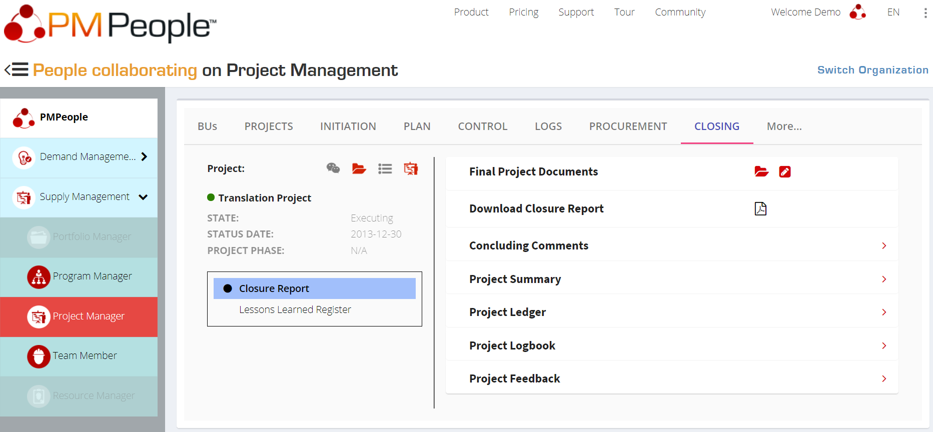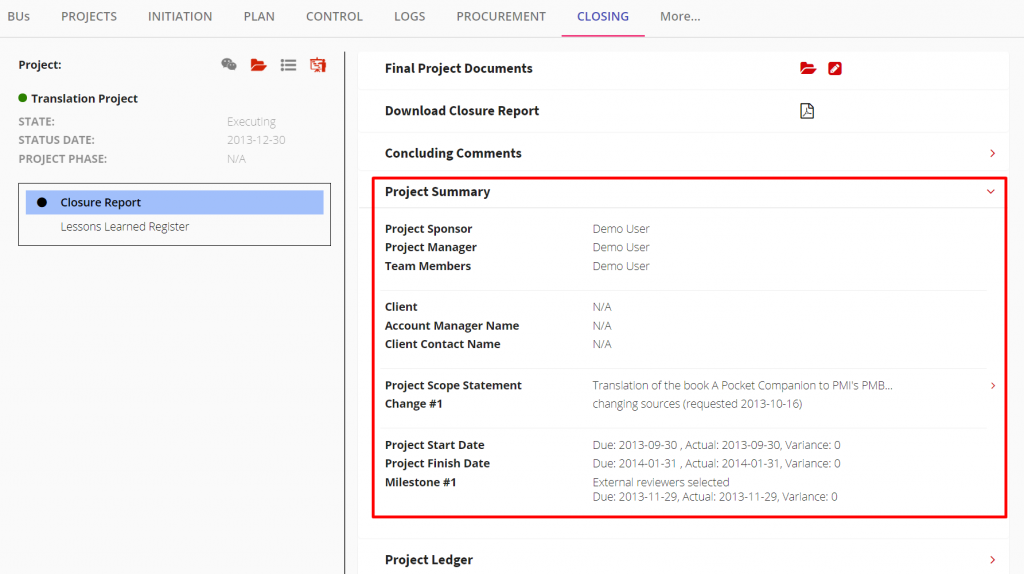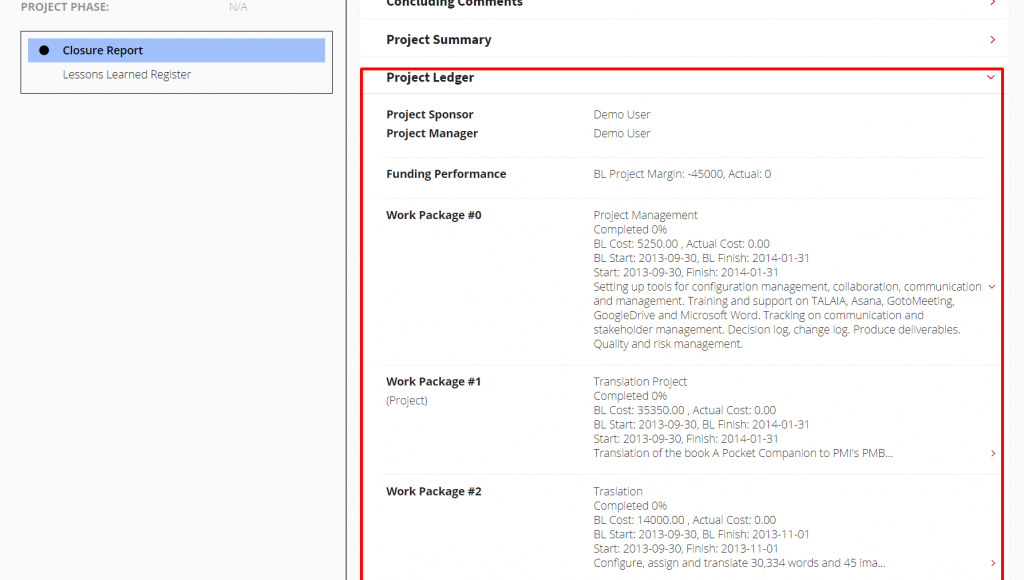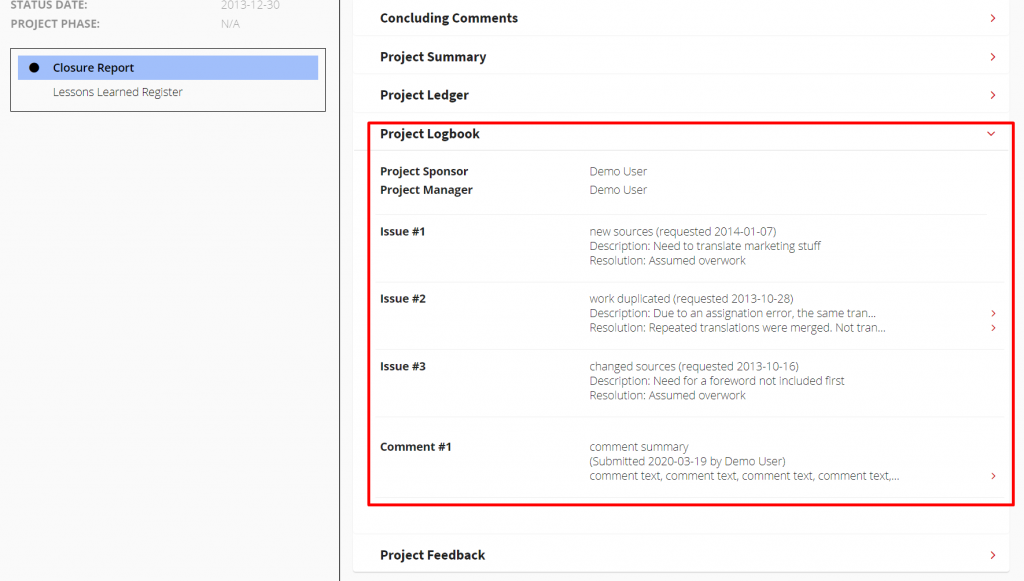When all project work is done, that is, deliverables are accepted, contracts are closed, the team members are released, the product of the project—product, service or final result—is properly transitioned to operations with the right training, etc., there is still some work to do: You have to perform the project formal closure.
When the project technical work is done, there is something else to do: You have to perform the project formal closure.
While closing the project or phase, PMPeople can help effective communication with stakeholders, specially nervous since they know they won’t be able to request more changes and they need to make sure all their project requirements are met. Professional project managers know that their performance will be appraised at the project closing: Project Managers are considered good professionals only if they meet the project management objectives.
Projects start with the end in mind. They are to finish on time, at a certain date. Other management goals, no less important, are to finish on budget, delivering some products and not others, getting the products look good from the client’s perspective, etc. If it can go forever, call it operation, not project. The need to be finished is the most distinguishing trait of a project.
Some faulty projects deliver excellent products, though. They can finish too late, over budget, etc. Projects fails when they do not meet the management goals. Professional project managers work to get the project finished on time, on budget, within the funding limits, delivering high quality products, within the scope, expectations met, getting a cohesive synergetic team, contracts closed, the product transitioned to operations, the value delivered, and the business case still on target.
Being each project management goal quite important, all projects should be value driven. However, organizations are typically more concerned about time and cost. While projects are on execution, top managers are worried about costs since there are only negative cash flows. Finance people see projects as investments using resources, paying contractors, buying assets, and causing many expenses. Positive cash flows will occur after the project is finished. Return on investment forecast after a number of years can be properly calculated in operation phase.
Likewise, professional project managers are more concerned on time and cost. If a project fails with poor value delivered, there is usually a business environmental explanation. If a project finish too late or too over budget, then the project manager is the one to blame. Not fair, but this is how it is. No manager would state that openly, but this is the main reason why organizations want professional project managers in charge: to get someone to blame if the project is not finished on time and on budget.
Project Managers develop many closing activities, including:
- Obtain final acceptance of the project deliverables from relevant stakeholders in order to confirm that project scope and deliverables were achieved.
- Transfer the ownership of deliverables to the assigned stakeholders in accordance with the project plan in order to facilitate project closure.
- Obtain financial, legal, and administrative closure using generally accepted practices and policies in order to communicate formal project closure and ensure transfer of liability.
- Prepare and share the final project report according to the communications management plan in order to document and convey project performance and assist in project evaluation.
- Collate lessons learned that were documented throughout the project and conduct a comprehensive project review in order to update the organization’s knowledge base.
- Archive project documents and materials using generally accepted practices in order to comply with statutory requirements and for potential use in future projects and audits.
- Obtain feedback from relevant stakeholders using appropriate tools and techniques and based on the stakeholder management plan in order to evaluate their satisfaction.
Project closing data are easy to access in PMPeople. Tab CLOSING can be accessed any time, not only when the project is closing. This tab is automatically opened when the project state is “closing”—no time/expense reporting allowed—or “archived”—no updating allowed. Project Managers can access project closing information:
- Closure Report can be read.
- Lessons Learned Register can be updated.
In this post, we are detailing the implementation developed at PMPeople for the Closure Report.
Online generated project closure reports saves plenty of time to organizations passing ISO auditing processes. However, the main value is related with managers able to check the final closure report in real time, while the project is in execution. Mananing “ with the end in mind ” enhances professional project management.
El Project Manager (PM), u otro rol gestor equivalente (Program Manager, Portfolio Manager, PMO Supportive, PMO, Requester y Sponsor), pueden visualizar la información del informe de cierre del proyecto en CIERRE > Informe de Cierre.
Project Managers (PM) and other managers (Program Manager, Portfolio Manager, PMO Supportive, PMO, Requester and Sponsor), can view the information of the project closure report at CLOSING > Closure Report:

Closure Report features are described below.
Feature 1) Access the shared folder with the Final Project Documents
Feature 2) Download the Closure Report as a PDF file:

Feature 3) Edit a text box with the Concluding Comments on the project performance:

Feature 4) Project Summary shows the information on the client, scope statement, approved changes, dates and global milestones:

Feature 5) Project Ledger shows the information on the financial project margin and also information on each work package—including the project summary task—with the performance data on scope, schedule and cost:

Feature 6) Project Logbook shows issues and comments in chronological order:

Feature 7) Project Feedback shows feedbacks coming from Stakeholders (SH), Requesters (RQ) and Sponsors (SP) in chronological order:

This video shows how to manage online closure reports with PMPeople :
Project Closure in PMPeople
PMPeople is the tool for the Project Economy. All types of organizations manage projects, programs, and portfolios to turn ideas into reality. Organizations are getting “projectified” and need project professionals to ensure predictability, accountability, and final success of each project.
PMPeople is a technology for project professionals to collaborate using roles. Launched in April 2018 for PMOs and project professionals using 12 collaborative roles to work in teams professionally, in the cloud, collaborating on projects, programs and portfolios.
PMPeople goes beyond simply following workflows, chains of supervision, processes, or document templates: it promotes people interact as individuals. Project Managers can manage projects at many organizations using predictive and agile frameworks. Stakeholders can supervise many projects and give feedback with their mobile application. Team members can know their teammates and job descriptions, submit comments, timesheets, expenses, etc.
PMPeople is aimed to unify professional project management by these differential points:
- Designed by and for professional project managers, following professional project management standards.
- Online productivity –less meetings, less documents, less workflows– through distributed collaboration among 12 specialized roles: Organization Owner, 6 roles on demand management and 5 roles on supply management.
- Freemium product –unlimited time, unlimited users– usable via web and mobile application.
Start using PMPeople for free, for unlimited time and for any number of users. In premium organizations, only managers have a cost. Several roles –stakeholders, team members, sponsors, and resource managers– are always free. You can increase or decrease your premium seats according to the organization’s actual needs. Premium organizations have access to our online interactive support. Our servers are located in the EU. This software can also be hosted on customer premises.
Jose Barato
Related posts
Categories
- Business (16)
- Demand Management Roles (14)
- Frequently Asked Questions (7)
- Guide (26)
- People (23)
- Assignments (2)
- Feedback (2)
- Project Team (3)
- Tracking Time And Expenses (2)
- Process (9)
- Closing (2)
- Executing And Controlling (2)
- Planning (1)
- Project Management (67)
- Management Frameworks (18)
- Organization Owner (OO) (3)
- Project Economy (54)
- Tools (19)
- Supply Management Roles (5)
- Training (6)
- Uncategorized (1)





